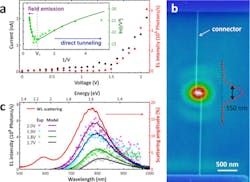An international group of scientists has demonstrated that the fundamental concepts of electrically driven radio antennas can also be applied to optical frequencies.1 The team believes that in bridging the gap between electronic and optical communication, their work signals the arrival of ultra-high-resolution displays and faster, smaller and more efficient computer chips.
The researchers electrically drove an optical nanoantenna via the broadband quantum-shot noise of electrons tunneling across its feed gap. The wavelength of the emitted photons were tuned by varying the applied voltage; the geometry of the antenna determined the emission direction. Potential uses include on-chip wireless communications and configurable electrically driven subwavelength photon sources, among others.
"The manipulation and characterization of optical fields on the nanoscale, and the creation and detection of light in such small volumes, is a significant breakthrough for computing and imaging," says Antoine Varagnat, Product Manager at Andor Technology. "Applications range from on-chip electro-optical communication over single-photon sources to near-field optical microscopy, both immensely important to modern society."
"We needed two key instruments and found both at Andor," says Bert Hecht of the University of Wurzburg. "In selecting the iXon 897 camera we got a very fast and highly sensitive EMCCD [electron-multiplying CCD] capable of acquiring images and spectra of the nanoantennas' electroluminescence at high repetition rates of up to 10 Hz. This meant we could associate each current-voltage value with the number of photons emitted. We also needed a spectrometer equipped with both a low-line-number grating and a mirror in the grating torrent in order to cover a wide spectral range per single shot, position the sample precisely, and acquire the Fourier image emission pattern efficiently. We already owned the Shamrock 303i spectrometer and the upgrade proved simple and cost-effective. Furthermore, the new iXon camera interfaced easily with our existing LabVIEW software and we really appreciated the 'step 'n glue' function, which allowed us to automatically acquire white-light spectra in very wide ranges. In our case we needed to acquire spectra from 400 to 11,000 nm."
For more info, see www.andor.com/cameras.
Source: Andor
REFERENCE:
1. Johannes Kern et al., Nature Photonics (2015); doi: 10.1038/nphoton.2015.141

